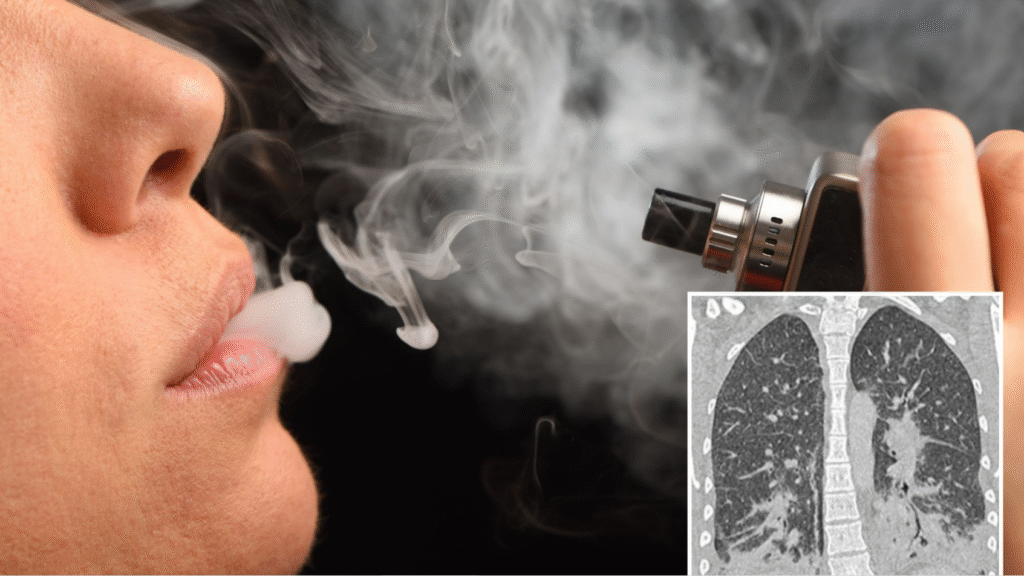“Popcorn lung” might sound harmless—even whimsical—but it’s a serious and potentially irreversible condition affecting the lungs. Officially known as bronchiolitis obliterans, popcorn lung gained widespread attention in the early 2000s when workers at microwave popcorn plants developed lung disease after being exposed to diacetyl, a chemical used for butter flavoring.
In recent years, this condition has reentered the spotlight due to its connection with vaping and e-cigarettes. If you’re wondering what popcorn lung is, how it develops, and what you can do to prevent it, this article covers everything you need to know.
What Is Popcorn Lung?
Popcorn lung is a slang term for bronchiolitis obliterans, a rare disease that causes scarring and inflammation in the smallest airways of the lungs (bronchioles). This damage leads to the narrowing and obstruction of airways, making it difficult to breathe and reducing overall lung function.
The term “popcorn lung” originated after a cluster of workers at a microwave popcorn manufacturing plant developed the disease. The culprit was identified as diacetyl, a chemical used to create a buttery flavor in foods.
Causes of Popcorn Lung
There are several causes of bronchiolitis obliterans (popcorn lung), but the most commonly cited are:
1. Diacetyl Exposure
Diacetyl is the key ingredient historically associated with popcorn lung. While the U.S. Occupational Safety and Health Administration (OSHA) now limits exposure in factories, diacetyl is still present in some flavored e-cigarettes and vape juices, raising concerns for users.
2. Vaping and E-Cigarettes
Many flavored vape products contain diacetyl or similar chemical compounds. When inhaled regularly, especially in poorly regulated products, this can cause irreversible lung damage. Studies have shown that some vape flavors contain levels of diacetyl far exceeding safety limits for occupational exposure.
3. Inhalation of Other Harmful Chemicals
Besides diacetyl, other chemicals such as acetoin and 2,3-pentanedione used in flavored products may also contribute to lung damage. Inhalation of chemical fumes from cleaning agents, paints, or industrial materials can similarly trigger bronchiolitis obliterans.
4. Infections
Severe respiratory infections like those caused by adenovirus, respiratory syncytial virus (RSV), or Mycoplasma pneumoniae can occasionally result in popcorn lung, especially in individuals with compromised immune systems.
5. Medical Treatments
Certain treatments such as lung or bone marrow transplants and chemotherapy have also been linked to bronchiolitis obliterans as a rare side effect.
Symptoms of Popcorn Lung
Popcorn lung symptoms can often mimic other respiratory diseases like asthma or chronic bronchitis, making it challenging to diagnose early. Key symptoms include:
Persistent dry cough
Shortness of breath
Wheezing
Fatigue
Rapid breathing
Unexplained weight loss (in some cases)
These symptoms usually develop gradually and worsen over time. Since the condition causes irreversible lung damage, early diagnosis is crucial to slow progression.
How Is Popcorn Lung Diagnosed?
If you suspect you may have popcorn lung, a healthcare provider will perform several tests:
Chest X-ray or CT scan: To detect lung inflammation or scarring.
Pulmonary function tests: To measure lung capacity and airflow.
Lung biopsy: In rare cases, a sample may be taken to confirm bronchiolitis obliterans.
Due to the similarity in symptoms with asthma or COPD, popcorn lung is often misdiagnosed initially.
Treatment Options
There is currently no cure for popcorn lung. However, treatments can manage symptoms and slow the progression of the disease:
1. Corticosteroids
Anti-inflammatory medications like prednisone can help reduce airway inflammation.
2. Bronchodilators
These medications help open up the airways, making breathing easier.
3. Oxygen Therapy
In advanced cases, supplemental oxygen might be needed to maintain adequate oxygen levels in the blood.
4. Lung Transplant
In severe, life-threatening cases, a lung transplant may be considered as a last resort.
Important: Quitting smoking or vaping is essential if you’re diagnosed with or at risk for popcorn lung.
Popcorn Lung and Vaping: What You Need to Know
Vaping has become increasingly popular among teens and young adults. While many assume it’s a safer alternative to smoking, flavored vape products often contain diacetyl or other harmful compounds.
According to research conducted by Harvard T.H. Chan School of Public Health, over 75% of flavored e-cigarettes and refill liquids tested contained diacetyl, even in products not listing it on the label.
Key Takeaways:
Flavored e-liquids pose a significant risk for popcorn lung.
Even short-term use of high-diacetyl vapes may cause damage.
Regulatory oversight for vape ingredients varies by country, making it difficult to guarantee safety.
How to Prevent Popcorn Lung
Preventing popcorn lung comes down to reducing or eliminating exposure to harmful chemicals:
Avoid vaping or smoking, especially flavored products with unknown ingredients.
Use protective gear if you work in environments where chemical inhalation is possible.
Ensure good ventilation in homes or workplaces where aerosols, fumes, or chemicals are used.
Stay up to date on vaccinations, especially if you have a weakened immune system.
See a doctor promptly if you develop persistent cough or breathing issues.
Frequently Asked Questions (FAQs)
Is popcorn lung caused by eating popcorn?
No. The condition is not caused by eating popcorn. It is linked to inhaling diacetyl, once commonly used in artificial butter flavoring.
Can you get popcorn lung from vaping once?
While rare, high levels of diacetyl inhaled even briefly may pose a risk, particularly in sensitive individuals. Chronic exposure is more dangerous.
Does popcorn lung go away?
Unfortunately, popcorn lung causes permanent lung damage. However, early detection and symptom management can significantly improve quality of life.
Final Thoughts
Popcorn lung is a serious respiratory disease with strong links to chemical inhalation, particularly through vaping and occupational exposure. As more research highlights the dangers of inhaling flavored vapor products, it’s essential to be informed about what you’re putting into your body.
If you vape or are exposed to industrial chemicals, monitor your respiratory health and seek medical attention if you experience persistent symptoms. Prevention and awareness are your best defenses against this silent yet serious lung disease.


